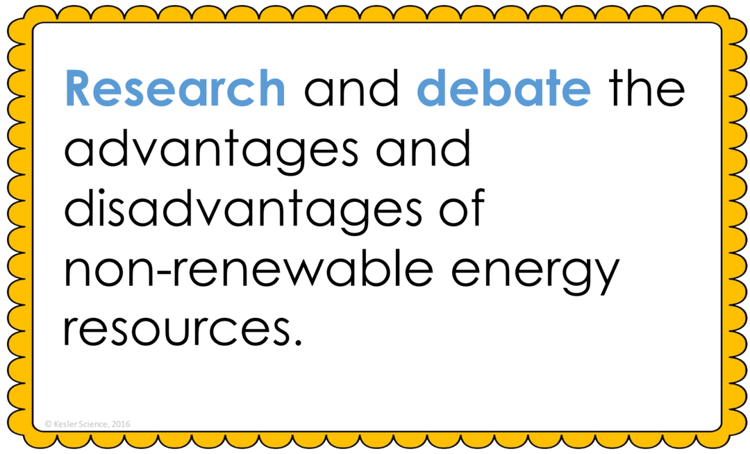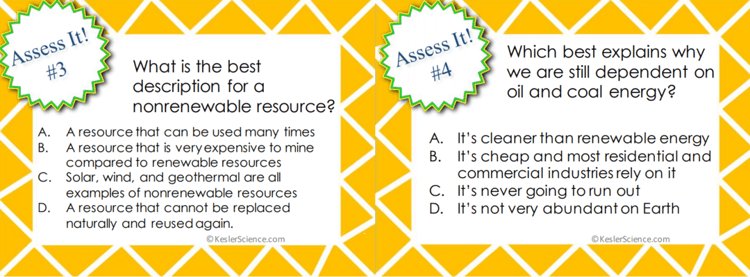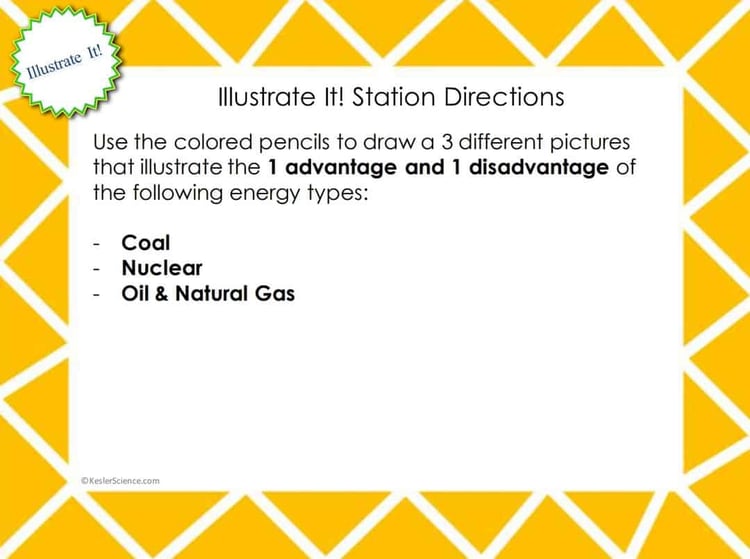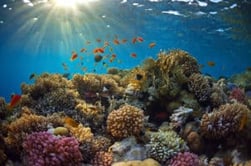NONRENEWABLE ENERGY RESOURCES LESSON PLAN – A COMPLETE SCIENCE LESSON USING THE 5E METHOD OF INSTRUCTION
At the end of this nonrenewable energy resources lesson plan, students will be able to research and debate the advantages and disadvantages of non-renewable energy resources. Each lesson is designed using the 5E method of instruction to ensure maximum comprehension by the students.
The following post will walk you through each of the steps and activities from the nonrenewable resources lesson plan.
ENGAGEMENT
Objective Introduction
At the beginning of the lesson, the class will do a Think-Pair-Share to discuss the objective.
Class Activity
- Tell students that energy comes from two types of resources: renewable and nonrenewable. This lesson focuses on nonrenewable resources (there is a separate 5E lesson on renewable energy). Break down the word renewable as it relates to energy, and explain what it means. (Renewable energy is generally defined as energy that is collected from resources which are naturally replenished on a human timescale.) Therefore, nonrenewable energy sources are not replenished on a human scale.
- Ask students if they have heard the term fossil fuels. What do they think that encompasses? As they watch the first video, see if they can name three types of fossil fuels, including nuclear energy.
Student Activity
- Show the video, “Non-Renewable Energy Resources” using the provided link.
- What are the three types of fossil fuels? (coal, oil, and natural gas) What is the other kind of energy mentioned in the video that is not considered a fossil fuel but is renewable? (nuclear) Why are these energy resources considered non-renewable? (Because they are not replenished on a human timescale.) How is electricity commonly generated? (heating water to steam, turning the turbine, converting energy to electricity through a generator)
- The next video “Electricity 101” shows how electricity is made from these resources. Stop at 2:28 when he begins talking about transporting electricity.

The teacher will help to clear any misconceptions about nonrenewable resources. A major misconception is that students do not understand how these energy resources are converted into electricity.
Estimated Class Time for the Engagement: 20-30 minutes
EXPLORATION
This student-centered station lab is set up so students can begin to explore nonrenewable resources. Four of the stations are considered input stations where students are learning new information about nonrenewable resources and four of the stations are output stations where students will be demonstrating their mastery of the input stations. Each of the stations is differentiated to challenge students using a different learning style. You can read more about how I set up the station labs here.
EXPLORE IT!
Students will be working in pairs to better understand nonrenewable energy resources. In this station, students interact with labels as they try to identify the types of nonrenewable resources. Students will follow the steps and record their observations on their lab sheet.
WATCH IT!
At this station, students will be watching a short video explaining nonrenewable resources. Students will then answer questions related to the video and record their answers on their lab station sheet. For example: According to the video, what are the advantages and disadvantages of fossil fuel energy? According to the video, what are the advantages and disadvantages of nuclear energy? Explain the process of how energy is extracted from fossil fuels (coal, oil, natural gas).
RESEARCH IT!
The research station will allow students to explore an interactive web page that helps them to understand nonrenewable resources. Students will be instructed to complete a few tasks and record answers on their lab sheets.
READ IT!
This station will provide students with a one page reading about the dangers of mining coal. There are 4 follow-up questions that the students will answer to show reading comprehension of the subject.
ASSESS IT!
The assess it station is where students will go to prove mastery over the concepts they learned in the lab. The questions are set up in a standardized format with multiple choice answers. Some questions include: Which is an advantage of coal energy? What is a disadvantage of energy from oil? What is the best description for a nonrenewable resource? Which best explains why we are still dependent on oil and coal energy?

WRITE IT!
Students who can answer open-ended questions about the lab truly understand the concepts that are being taught. At this station, the students will be answering three task cards: Why do you think most transportation in the U.S. is still running on fossil fuels? Suppose the city wanted to put a nuclear power plant in your community. What would some of the disadvantages be? What are disadvantages of a coal power plant?
ILLUSTRATE IT!
Your visual students will love this station. Students are to draw pictures that demonstrate their knowledge of nonrenewable resources (coal, nuclear, oil, and natural gas).

ORGANIZE IT!
Students at this station will match the sets of cards. Cards include objects and nonrenewable resources that the students will determine which would be a match. Once students have completed their organization, the teacher will check their understanding.
Estimated Class Time for the Exploration: 1-2, 45 minute class periods
EXPLANATION
The explanation activities will become much more engaging for the class once they have completed the exploration station lab. During the explanation piece, the teacher will be clearing up any misconceptions about nonrenewable resources with an interactive PowerPoint, anchor charts, and notes. The nonrenewable resources lesson includes a PowerPoint with activities scattered throughout to keep the students engaged.
The students will also be interacting with their journals while taking notes from the PowerPoint. If you have students that need modified notes, the 5E lessons come equipped to help give every student access to the lesson.
Estimated Class Time for the Exploration: 2-3, 45 minute class periods
ELABORATION
The elaboration section of the 5E method of instruction is intended to give students choice on how they can prove mastery of the concept. When students are given choice the ‘buy-in’ is much greater than when the teacher tells them the project they will have to create. The elaboration project will allow students to create a choice project as students extend their knowledge of nuclear energy and fracking (the removal of natural gases).
Estimated Class Time for the Elaboration: 2-3, 45 minute class periods (can also be used as an at-home project)
EVALUATION
The final piece of the 5E model is to evaluate student comprehension. Included in every 5E lesson is a homework assignment, assessment, and modified assessment. Research has shown that homework needs to be meaningful and applicable to real-world activities in order to be effective. When possible, I like to give open-ended assessments to truly gauge the student’s comprehension.
Estimated Class Time for the Elaboration: 1, 45 minute class period
DOWNLOAD THE FULL LESSON NOW
The full lesson is available for download from the Kesler Science Store. Save yourself a ton of time and grab it now.
Download Over $100 in FREE Resources
For Middle School Science
Simply create a login below and gain immediate access to a selection of our Kesler Science product line worth $100 - for FREE. There's a full version of every product type! You'll also join tens of thousands of middle school science teachers who receive timely tips and strategies straight to their inbox.






